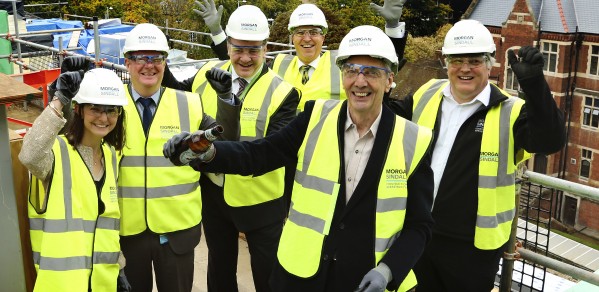
A topping out ceremony has been held for the James Dyson Building for Engineering in central Cambridge.
Developing the intellectual property that will help Britain succeed in the global technology race depends on applying our brightest minds to ambitious and exciting research projects.
James Dyson
Tom Dyson, James Dyson’s brother, fulfilled the duty by pouring a bottle of Elgoods Cambridge Bitter onto the roof to mark the event.
He was supported by Bob Ensch, Area Managing Director for Morgan Sindall, the main contractor for the new £13.3 million development, and Angus Stephen, Operations Director for the University’s Estate Management.
The building was made possible by a £6 million donation from the James Dyson Foundation. The Foundation has also funded the development of a design centre for undergraduate engineering students.
The James Dyson Building for Engineering will house postgraduates and support world leading research in areas including advanced materials, smart infrastructure, electric vehicles, and efficient internal combustion systems for cars.
The building has a central nervous system of sensors built into it, giving those working inside it a chance to use their surroundings for research and teaching.
Specialist knowledge on research strategies and funding advice will be available on-site, supported by Philip Guildford, Director of Research at the Department of Engineering.
Research undertaken in the hub will build on a rich tradition of invention: it was at Cambridge that Harry Riccardo pioneered the internal combustion engine and Frank Whittle revolutionised travel with his jet engine invention.
The Department is located at the heart of the Cambridge cluster, which has created over 1,500 spin-out companies over the last decade.
Technology we take for granted, including: Concorde ‘droop’ nose design, the microchips developed by ARM that now power 90% of the world’s mobile phones, and the pregnancy test.
James Dyson said: “Developing the intellectual property that will help Britain succeed in the global technology race depends on applying our brightest minds to ambitious and exciting research projects. I’m hopeful that this new space for Britain’s best engineers at the University of Cambridge will catalyse great technological breakthroughs that transform how we live”.
This article originally appeared on the University of Cambridge website.

